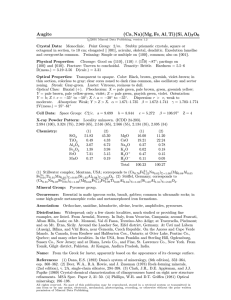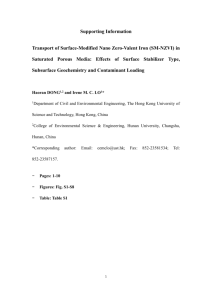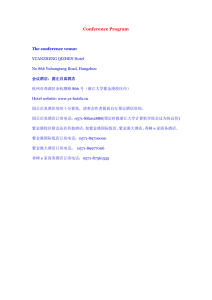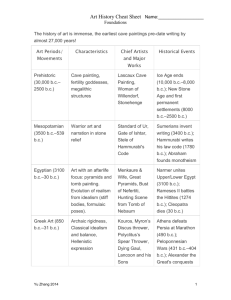Structure and : Bridging the Gap Reactivity of Nano-Particles
advertisement
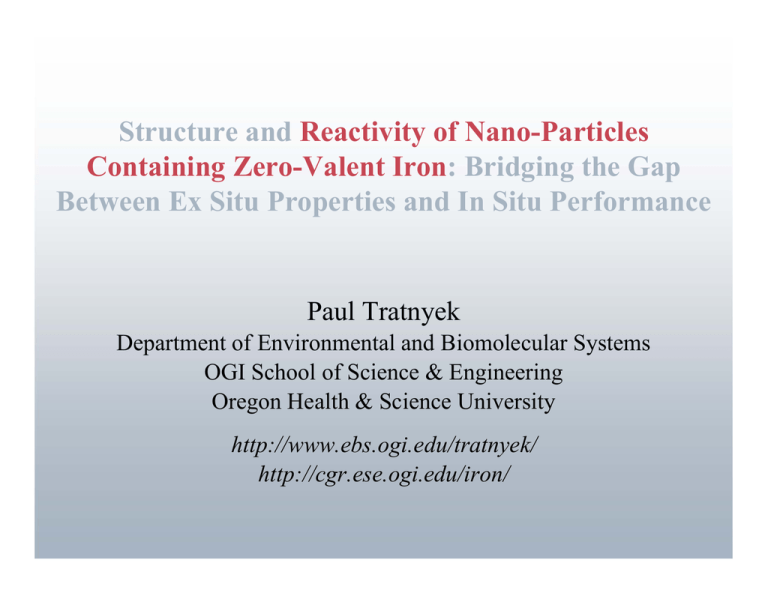
Structure and Reactivity of Nano-Particles Containing Zero-Valent Iron: Bridging the Gap Between Ex Situ Properties and In Situ Performance Paul Tratnyek Department of Environmental and Biomolecular Systems OGI School of Science & Engineering Oregon Health & Science University http://www.ebs.ogi.edu/tratnyek/ http://cgr.ese.ogi.edu/iron/ DOE BES/EMSP Project THE REACTION SPECIFICITY OF NANOPARTICLES IN SOLUTION Application to the Reaction of Nanoparticulate Iron and Iron-Bimetallic Compounds with Chlorinated Hydrocarbons and Oxyanions • • • • Synthesis and characterization of Fe and Fe-Oxide nanoparticles Measurements solution and gas reactivity with Fe nanoparticles Vacuum based studies of supported Fe nanoparticles Models of particle structure and effects of structure on reactivity Pacific Northwest National Laboratory: D. Baer, J. Amonette, J. Linehan , K. Pecher, B. Kay, Z. Dohnalek, M. Dupuis, E. Bylaska, A. El-Azab, others Oregon Health & Science University: P. Tratnyek, J. Nurmi, V. Sarathy University of Minnesota: L. Penn and M. Driessen Iron and Iron Oxides Studied BET Surface Area Major Phase Minor Phase Source Method Particle Size (dia.) Toda Americas, Inc. High temp. reduction of oxides with H2 70 nm 29 m2/g -Fe0 Magnetite FeBH W.-X. Zhang, Lehigh Univ. Precip. w/ NaBH4 10-100 nm 33.5 m2/g Fe0 Goethite, Wustite FeEL Fisher Scientific Electrolytic 150 µm 0.1-1 m2/g 99% Fe0 PNNL Precip from FeSO4 w/ KOH 30-100 nm 4-24 m2/g Fe3O4 Nanotek, Corp. Physical Vapor Synthesis (PVS) 23 nm 50 m2/g Fe2O3 Name Fe H2 Fe3O4 Fe2O3 Nurmi et al. (2005) ES&T 39: 1221-1230. Structure from TEM FeH2 (Toda) FeBH (Zhang) 5 nm 3.642 A 3.521 A Nurmi et al. (2005) ES&T 39: 1221-1230. 3.521 A Particle Size from TEM Nurmi et al. (2005) ES&T 39: 1221-1230. Composition from XPS FeH2 (Toda) Nurmi et al. (2005) ES&T 39: 1221-1230. FeBH (Zhang) Summary of Structure/Composition Sample History Mean Particle Size from TEM (nm) Shell Thickness (nm) TEM Structure XRD (Grain Size nm) XPS STXM FeH2 As-received ~38 Fe0 >60 nm oxide plates Fe-Oxide ~3.4 “large”plates (oxide) and smaller Fe0 irregularly shaped particles with crystalline oxide shell Fe0 (~30) oxide (~60) Fe0+Fe+3 Fe0 + oxide FeH2 Flash-dried ~44 Fe0 Name Fe BH FeBH As-received Flash-dried ~59 (20-100) ~67 (20-100) Less Fe0 As above with more large plates ~2.3 Three levels of structure: i) small crystallites (<1.5 nm), ii) 20-100 nm spherical aggregates with an amorphous coating, and iii) chains of 20-100 nm particles ~3.2 As above with thicker coating Nurmi et al. (2005) ES&T 39: 1221-1230. Mostly Fe0 (<1.5) Fe0+Fe+3 + B and Na Less Fe0 +B and Na Mostly Fe0 Solution Chemistry—Methods Electrochemical Cell Batch Reactor • Flash drying • Flash drying • Packed powder • Pre-exposure period electrode • Fabrication • Validation • Data presentation • Buffer selection • Electrochemical model • Ox/Fe ratio • Mixing rate • Kinetic model Protocol for Batch Experiments Adding deox. DI water Spiking Time = t0 Fe0 Mixing HPLC GC/ECD UV/VIS Analysis • Flash drying • Pre-exposure period Sampling Time = t1 , t2 , t3 … • Buffer selection • Ox/Fe ratio Nurmi et al. (2005) ES&T 39: 1221-1230. Sarathy and Tratnyek (in prep.) • Mixing rate • Kinetic model Batch Experiments with CCl4 - CCl4 (CT) + Fe(0) r CHCl3 (CF) + Unk + Cl + Fe(II) 1. pH: • 7.3, 8.4, 9.0 2. Buffers: • Borate • EPPS 3. Type: • Fisher Electrolytic • Nano (Zhang, Toda) 4. Pretreatment: • Flash drying Nurmi et al. (2005) ES&T 39: 1221-1230. Sarathy and Tratnyek (in prep.) ksa vs. km plots From: kM = kSA as It follows that: log kSA = log kM – log as Plotting log kSA vs. log kM gives contours of constant as. Cimitan et al. (2005) J. Med. Chem. ASAP Nurmi et al. (2005) ES&T 39:1221. Tratnyek (in prep.) Effect of Surface Area—Our Data Only • kM (Nano > Micro) • kM (FeBH ? FeH2) • as (TEM < BET) • kSA (Nano Micro) • kSA (Nano < Micro) … Uncertainties in as are important … No “intrinsic” nanosize effect Nurmi et al. (2005) ES&T 39: 1221-1230 Chloroform Yield Nurmi et al. (2005) ES&T 39: 1221-1230. Sarathy et al. (in prep.) Application to Site Remediation • • • 200 W Area of Hanford – 750,000 kg spilled – Vadose and GW zones – 11 km2 plume – up to 7000 ug/L ITRD TAG since 1999 – Completed PITT – Reviewed Natural Attenuation – Modeled Reactive-Transport – Reviewed Treatment Options Status – Active intervention probably needed soon – “Critical” Need for Remediation Technology (TIP No. 0006) DOE Various Sources Summary and Credits Summary: • Nano Fe0 has a shell of Fe3O4, other oxides, and impurities. • Specific surface area is an important and challenging property. • Nano Fe0 gives greater km, but not necessarily greater kSA. • Some nano Fe0 gives more favorable products (low YCF). • Low YCF and injectability offer prospects for remediation. Funding: • DOE Office of Science, Nanoscale Science, Engineering, and Technology Program (DE-AC05-76RLO 1830) • DOE Office of Science, Environmental Management Sciences Program (DE-FG07-02ER63485) • SERDP and ESTCP Acknowledgements 1. Tratnyek Group Vaish Sarathy, Jim Nurmi, Joel Bandstra (PSU) Bumhan Bae (Kyungwon Univ.) 2. Pacific Northwest National Laboratory Don Baer, J. Amonette, E. Bylaska, Z. Dohnalek, M. Dupuis, A. El-Azab, B. Kay, J. Linehan , K. Pecher, J. Rustad 3. Other Collaborators R. Lee Penn and M. Driessen (U. Minnesota), Y. Qiang and J. Antony (U. Idaho), Rick Johnson (OHSU) 4. Samples K. Okinaka and Andy Jazdanian (Toda Kogyo Corp.) W.-X. Zhang (Lehigh U.) Clint Bickmore (OnMaterials, LLC) D. Vance (Arcadis), and others
